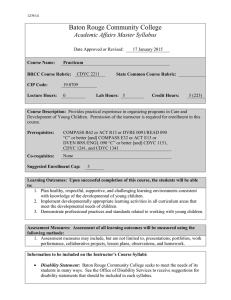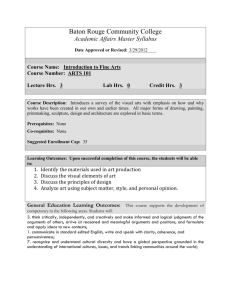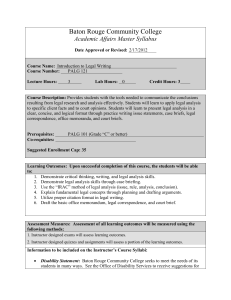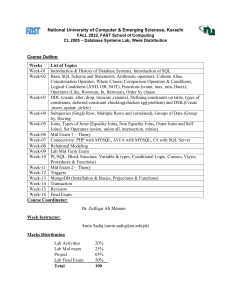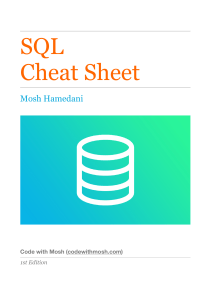Baton Rouge Community College Academic Affairs Master Syllabus
advertisement
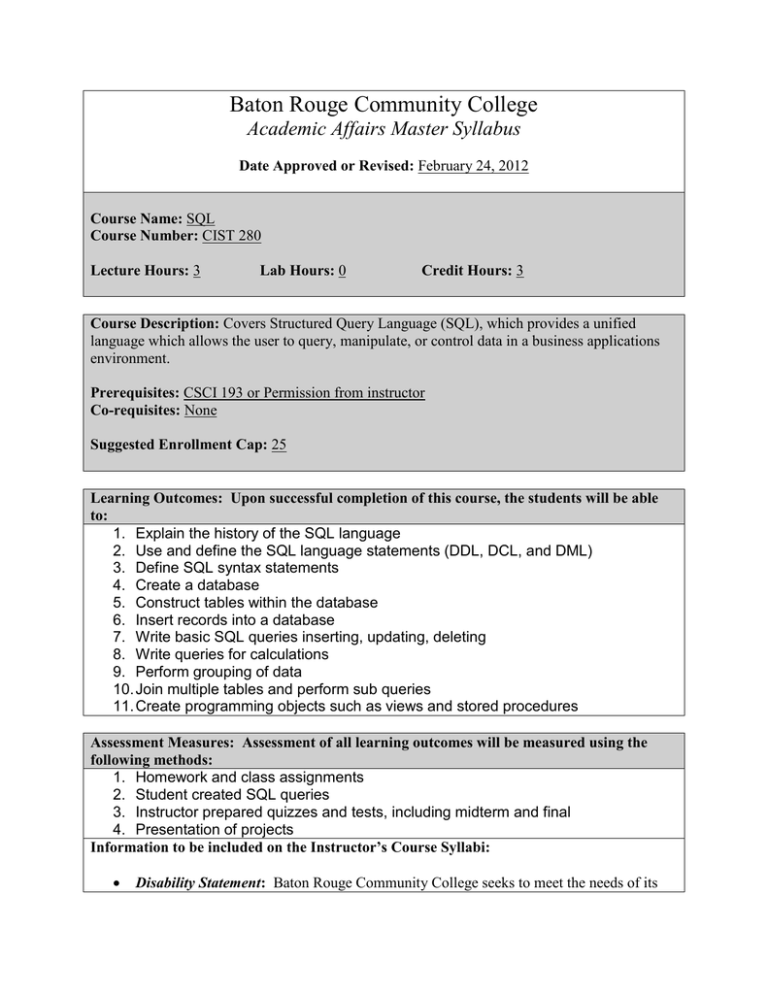
Baton Rouge Community College Academic Affairs Master Syllabus Date Approved or Revised: February 24, 2012 Course Name: SQL Course Number: CIST 280 Lecture Hours: 3 Lab Hours: 0 Credit Hours: 3 Course Description: Covers Structured Query Language (SQL), which provides a unified language which allows the user to query, manipulate, or control data in a business applications environment. Prerequisites: CSCI 193 or Permission from instructor Co-requisites: None Suggested Enrollment Cap: 25 Learning Outcomes: Upon successful completion of this course, the students will be able to: 1. Explain the history of the SQL language 2. Use and define the SQL language statements (DDL, DCL, and DML) 3. Define SQL syntax statements 4. Create a database 5. Construct tables within the database 6. Insert records into a database 7. Write basic SQL queries inserting, updating, deleting 8. Write queries for calculations 9. Perform grouping of data 10. Join multiple tables and perform sub queries 11. Create programming objects such as views and stored procedures Assessment Measures: Assessment of all learning outcomes will be measured using the following methods: 1. Homework and class assignments 2. Student created SQL queries 3. Instructor prepared quizzes and tests, including midterm and final 4. Presentation of projects Information to be included on the Instructor’s Course Syllabi: Disability Statement: Baton Rouge Community College seeks to meet the needs of its students in many ways. See the Office of Disability Services to receive suggestions for disability statements that should be included in each syllabus. Grading: The College grading policy should be included in the course syllabus. Any special practices should also go here. This should include the instructor’s and/or the department’s policy for make-up work. For example in a speech course, “Speeches not given on due date will receive no grade higher than a sixty” or “Make-up work will not be accepted after the last day of class.” Attendance Policy: Include the overall attendance policy of the college. Instructors may want to add additional information in individual syllabi to meet the needs of their courses. General Policies: Instructors’ policy on the use of things such as beepers and cell phones and/or hand held programmable calculators should be covered in this section. Cheating and Plagiarism: This must be included in all syllabi and should include the penalties for incidents in a given class. Students should have a clear idea of what constitutes cheating in a given course. Safety Concerns: In some programs this may be a major issue. For example, “No student will be allowed in the safety lab without safety glasses.” General statements such as, “Items that may be harmful to one’s self or others should not be brought to class.” Library/ Learning Resources: Since the development of the total person is part of our mission, assignments in the library and/or the Learning Resources Center should be included to assist students in enhancing skills and in using resources. Students should be encouraged to use the library for reading enjoyment as part of lifelong learning. Expanded Course Outline: I. Storing Information in Tables A. Introduction B. The Parts of a Table C. Examples of Tables II. Getting Information from a Table A. The Select Statement B. The Select Clause C. The Where Clause D. The Order By Clause III. Compound Conditions in the Where Clause A. Compound Conditions in the Where Clause B. Constant Values C. Punctuation Matters D. Case Sensitivity E. Three-Valued Logic F. Error Messages IV. Saving Your Results A. Saving Your Results in a New Table or View B. Modifying the Data in a Table with SQL C. Modifying the Data in a Table with the GUI D. Restrictions on Modifying the Data in a Table V. Creating Your Own Tables A. Creating Tables B. Changing Tables C. Tables with Duplicate Rows VI. Calculations A. Calculated Fields B. Literal Values C. Arithmetic Calculations VII. Inner Joins A. Introduction to Joins B. Inner Joins of Two Tables C. Variations of the Join Condition D. Applications of Joins


